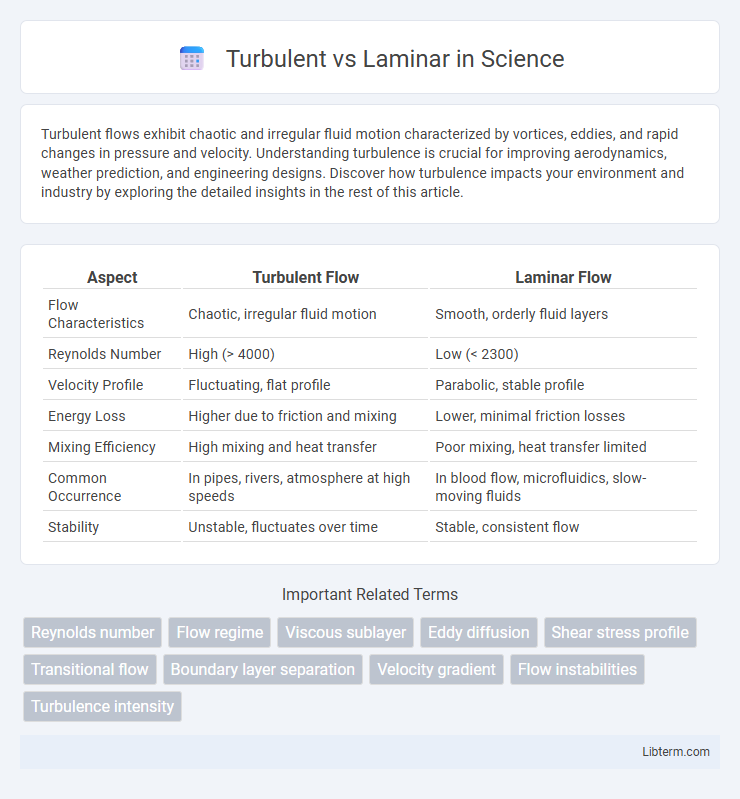Turbulent flows exhibit chaotic and irregular fluid motion characterized by vortices, eddies, and rapid changes in pressure and velocity. Understanding turbulence is crucial for improving aerodynamics, weather prediction, and engineering designs. Discover how turbulence impacts your environment and industry by exploring the detailed insights in the rest of this article.
Table of Comparison
| Aspect | Turbulent Flow | Laminar Flow |
|---|---|---|
| Flow Characteristics | Chaotic, irregular fluid motion | Smooth, orderly fluid layers |
| Reynolds Number | High (> 4000) | Low (< 2300) |
| Velocity Profile | Fluctuating, flat profile | Parabolic, stable profile |
| Energy Loss | Higher due to friction and mixing | Lower, minimal friction losses |
| Mixing Efficiency | High mixing and heat transfer | Poor mixing, heat transfer limited |
| Common Occurrence | In pipes, rivers, atmosphere at high speeds | In blood flow, microfluidics, slow-moving fluids |
| Stability | Unstable, fluctuates over time | Stable, consistent flow |
Understanding Turbulent and Laminar Flow
Turbulent flow is characterized by chaotic fluid motion with irregular fluctuations and eddies, leading to enhanced mixing and higher energy dissipation compared to laminar flow, which exhibits smooth, orderly layers of fluid moving in parallel. Understanding turbulent flow is crucial for optimizing engineering systems such as pipelines and aircraft design, where controlling drag and heat transfer is essential. Laminar flow typically occurs at low Reynolds numbers, while turbulence emerges at higher Reynolds numbers, indicating a transition influenced by velocity, viscosity, and characteristic length scales.
Key Differences Between Laminar and Turbulent Flow
Laminar flow is characterized by smooth, orderly fluid motion with parallel layers and minimal mixing, typically occurring at low Reynolds numbers below 2,300. Turbulent flow exhibits chaotic, irregular fluctuations and strong mixing, common at Reynolds numbers above 4,000. Key differences include velocity profile uniformity, energy dissipation rates, and flow stability, with laminar flow having a linear velocity gradient and turbulent flow showing velocity fluctuations and enhanced momentum transfer.
Characteristics of Laminar Flow
Laminar flow is characterized by smooth, parallel layers of fluid that move in an orderly fashion with minimal mixing between adjacent layers, resulting in low velocity fluctuations and reduced turbulence. The flow exhibits a low Reynolds number, typically below 2,000, indicating dominant viscous forces over inertial forces. This stable and predictable behavior is crucial for applications requiring precise fluid control, such as in microfluidics and aerodynamic testing.
Features of Turbulent Flow
Turbulent flow is characterized by chaotic fluid motion, high velocity fluctuations, and enhanced mixing, leading to increased momentum and heat transfer compared to laminar flow. It exhibits irregular, unpredictable eddies and vortices, causing greater energy dissipation and pressure losses in pipelines or channels. Turbulent flow typically arises at high Reynolds numbers, indicating a dominance of inertial forces over viscous forces within the fluid.
Factors Influencing Flow Regimes
Flow regimes such as turbulent and laminar are primarily influenced by factors including fluid velocity, viscosity, and characteristic length scale, which together determine the Reynolds number. Low Reynolds numbers indicate laminar flow with smooth, orderly fluid motion, while high Reynolds numbers signal turbulent flow characterized by chaotic eddies and mixing. Surface roughness and fluid density also play critical roles in transitioning between these flow regimes, impacting engineering designs and fluid dynamic applications.
Reynolds Number: The Deciding Factor
Reynolds number is the key dimensionless parameter that distinguishes turbulent from laminar flow by quantifying the ratio of inertial forces to viscous forces within a fluid. Low Reynolds numbers (typically below 2000) indicate laminar flow characterized by smooth, orderly fluid motion, while high Reynolds numbers (above 4000) signify turbulent flow with chaotic fluid fluctuations. This threshold determines the onset of turbulence and is critical in engineering applications to predict flow behavior and optimize fluid dynamics systems.
Practical Examples in Engineering and Nature
Turbulent flow in engineering is common in pipelines, where high velocity causes chaotic fluid motion, increasing mixing and heat transfer efficiency, as seen in HVAC systems and turbojet engines. Laminar flow appears in microfluidic devices and blood vessels, characterized by smooth, parallel layers that minimize friction and wear, enhancing precision and reducing energy loss. In nature, rivers exhibit turbulent flow with rapid currents and eddies, while slow-moving streams or thin oil films demonstrate laminar flow, crucial for sediment transport and organism habitats.
Impacts on Fluid Resistance and Efficiency
Turbulent flow increases fluid resistance due to chaotic eddies and fluctuations, leading to higher energy losses compared to smooth laminar flow. Laminar flow maintains streamlined layers, minimizing drag and enhancing the efficiency of fluid transport systems. The transition between these flow regimes significantly impacts pump and pipe design, influencing overall system performance and energy consumption.
Applications in Industry and Technology
Turbulent flow, characterized by chaotic fluid motion and high momentum diffusion, is preferred in industrial mixing processes, combustion engines, and chemical reactors for enhanced heat and mass transfer. Laminar flow, with its smooth and orderly layers, is critical in microfluidics, pharmaceutical manufacturing, and semiconductor fabrication where precise control and minimal mixing are essential. Understanding the distinct properties of turbulent and laminar flows enables optimization in applications ranging from pipeline transport to aerospace engineering, improving efficiency and product quality.
Selecting the Right Flow Regime for Your Needs
Choosing between turbulent and laminar flow depends on the specific application requirements such as heat transfer efficiency, pressure drop, and flow stability. Laminar flow offers predictable, smooth fluid motion ideal for processes needing minimal mixing and low shear stress, while turbulent flow enhances mixing, heat transfer, and mass transport at the cost of increased energy consumption and potential noise. Evaluating factors like Reynolds number, fluid properties, and desired outcome allows engineers to optimize performance by selecting the appropriate flow regime for pipelines, reactors, or HVAC systems.
Turbulent Infographic

 libterm.com
libterm.com